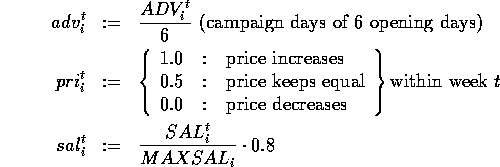 .
We assume that the necessary information is given for T weeks in the past.
With the following definitions
.
We assume that the necessary information is given for T weeks in the past.
With the following definitions
An efficient preprocessing of the data is necessary to input it into the net.
All information must be normalized to fit into the interval  .
We assume that the necessary information is given for T weeks in the past.
With the following definitions
.
We assume that the necessary information is given for T weeks in the past.
With the following definitions

we have decided to use the following inputs for each article i and week t:

For each article i and recent week t we use a three-dimensional vector:

For a week t in the future the vector is reduced by the unknown sale:

To predict the sale for one article within a week t, we use a window of the last n weeks. So we have the following input vector for each article i:

Because all the considered articles belong to one product group, we have quite a constant sales volume of all products. An increasing sale of one article in general leads to a decrease of the other sales. Due to this, we concatenate the input vectors of all p articles to get the vector given to the input layer:

The sale of article i within week t ( ) is the requested nominal value
in the output layer that has to be learned by one net for this
) is the requested nominal value
in the output layer that has to be learned by one net for this  vector.
So we have p nets and the i-th net adapts the sale behaviour of article i.
Therefore we have a training set with the following pairs (see figure 4):
vector.
So we have p nets and the i-th net adapts the sale behaviour of article i.
Therefore we have a training set with the following pairs (see figure 4):

To forecast the unkown sale  for any article i within a future week T+1 we give
the following input vector to the trained i-th net:
for any article i within a future week T+1 we give
the following input vector to the trained i-th net:

The output value of this net is expected to be the value  ,
which has to be re-scaled to the value for the sale of article i within week T+1:
,
which has to be re-scaled to the value for the sale of article i within week T+1:
